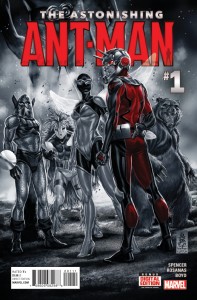 The Astonishing Ant-Man #1 — Writer: Nick Spencer; Art: Ramon Rosanas; Colors: Jordan Boyd
The Astonishing Ant-Man #1 — Writer: Nick Spencer; Art: Ramon Rosanas; Colors: Jordan Boyd
The Uncanny Inhumans #1 — Writer: Charles Soule; Pencils: Jay Leisten; Inks: Steve McNiven; Colors: Sunny Cho
Karnak #1 — Writer: Warren Ellis; Art: Gerardo Zaffino; Colors: Dan Brown
Marvel continues its reboot rollout with three new titles this week: Ant-Man has some imaginative ideas from Spencer — like a Silicon Valley entrepreneur who’s created an Uber-like app for supervillains: need a hero assassinated? It’ll find whoever’s closest and dispatch them to do the job, as Scott Lang 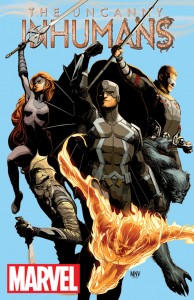 finds out to his dismay. There’s a little too much of the lovable loser in his characterization — he can’t catch a break in anything, and there’s a last-page reveal that makes it even worse — but Spencer is a clever writer who plays a long game, and I’m guessing it’ll all work out over the inevitable six-issue arc that will make up the first volume of this book. The Inhumans debut continues Marvel’s attempt to downplay the X-Men (whose movie and TV rights they don’t own) and substitute the mutation-friendly Kree castoffs instead, right down to their “Uncanny” adjective. Thanks to the terrigen mists, there are a lot of new characters running around, but that risks confusing readers, especially since the “old” Inhumans aren’t that easy to get to know (the perpetually-silent Black Bolt takes “inscrutable” to new levels, and Medusa, whose Rapunzel-like hair makes her the most visually-arresting character, often seems too much the ice queen — although Soule
finds out to his dismay. There’s a little too much of the lovable loser in his characterization — he can’t catch a break in anything, and there’s a last-page reveal that makes it even worse — but Spencer is a clever writer who plays a long game, and I’m guessing it’ll all work out over the inevitable six-issue arc that will make up the first volume of this book. The Inhumans debut continues Marvel’s attempt to downplay the X-Men (whose movie and TV rights they don’t own) and substitute the mutation-friendly Kree castoffs instead, right down to their “Uncanny” adjective. Thanks to the terrigen mists, there are a lot of new characters running around, but that risks confusing readers, especially since the “old” Inhumans aren’t that easy to get to know (the perpetually-silent Black Bolt takes “inscrutable” to new levels, and Medusa, whose Rapunzel-like hair makes her the most visually-arresting character, often seems too much the ice queen — although Soule  introduces an interesting way to thaw her out here). The art’s decent-looking, although the cover uses a bit of a bait and switch: it lists Steve McNiven, a popular artist, first on the cover credits, but it turns out he’s only providing inks over Jay Leisten’s pencils. Karnak, meanwhile, isn’t necessarily the Inhuman you’d expect to get his own book, but anything by Warren Ellis is worth checking out, and he offers an intriguing stoic/Zen take on the character, who’s now the magister/priest of a “Tower of Wisdom,” and only leaves it to take on high-paying, special-ops, Inhuman-centric missions for S.H.I.E.L.D. Zaffino’s austere, dark-toned art is appropriate to the shadowy goings-on, and if you like Ellis’s combination of cerebral philosophizing and, you know, people punching one another, you’ll like this comic.
introduces an interesting way to thaw her out here). The art’s decent-looking, although the cover uses a bit of a bait and switch: it lists Steve McNiven, a popular artist, first on the cover credits, but it turns out he’s only providing inks over Jay Leisten’s pencils. Karnak, meanwhile, isn’t necessarily the Inhuman you’d expect to get his own book, but anything by Warren Ellis is worth checking out, and he offers an intriguing stoic/Zen take on the character, who’s now the magister/priest of a “Tower of Wisdom,” and only leaves it to take on high-paying, special-ops, Inhuman-centric missions for S.H.I.E.L.D. Zaffino’s austere, dark-toned art is appropriate to the shadowy goings-on, and if you like Ellis’s combination of cerebral philosophizing and, you know, people punching one another, you’ll like this comic.
 Secret Wars: Age of Apocalypse #5 (of 5) — Writer: Fabian Nicieza; Art: Iban Coello; Colors: David Curiel
Secret Wars: Age of Apocalypse #5 (of 5) — Writer: Fabian Nicieza; Art: Iban Coello; Colors: David Curiel
Secret Wars: 1872 #4 (of 4) — Writer: Gerry Duggan; Art: Nik Virella; Colors: Lee Loughridge
Secret Wars: Weirdworld #5 (of 5) — Writer: Jason Aaron; Art: Mike del Mundo; Colors: Mike De Mundo and Marco D’Alfonso
Your handful of Secret Wars mini-series conclusions for the week. Age of Apocalypse has been a typical 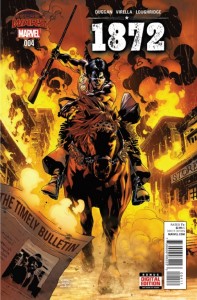 “Elseworlds”-type story all along, and ends that way too, with pyrotechnics and game-changing results for all the characters (whom, once the main SW book ends, we’ll never see again anyway); it’s good if you were a fan of the original AofA books, but dismissable otherwise. 1872 is more interesting, because its main character, Red Wolf, is getting his own book as part of the Marvel relaunch; there are also hints that the old-West town of Timely and its 19th-century Avengers-ish inhabitants (Tony Stark, Carol Danvers, Natasha Romanov, etc.) will get more stories
“Elseworlds”-type story all along, and ends that way too, with pyrotechnics and game-changing results for all the characters (whom, once the main SW book ends, we’ll never see again anyway); it’s good if you were a fan of the original AofA books, but dismissable otherwise. 1872 is more interesting, because its main character, Red Wolf, is getting his own book as part of the Marvel relaunch; there are also hints that the old-West town of Timely and its 19th-century Avengers-ish inhabitants (Tony Stark, Carol Danvers, Natasha Romanov, etc.) will get more stories  later, with a familiar pair of bounty hunters waiting in the wings, and a glowing green footprint suggesting future developments. So too for Weirdworld, which ends abruptly (apparently with the Secret Wars Battleworld planet blowing up, although I’m not sure that’s exactly a spoiler), but then sows the seeds for its return as a regular title in a few months, complete with Arkon, Morgan Le Fay, various Man-Things and the obscure ’80s characters Skull the Slayer and Crystar. That’s a spicy gumbo of ingrediants for Aaron to play with, and combined with del Mundo’s cool-looking fantasy-centric art should bring a lot of readers back for more.
later, with a familiar pair of bounty hunters waiting in the wings, and a glowing green footprint suggesting future developments. So too for Weirdworld, which ends abruptly (apparently with the Secret Wars Battleworld planet blowing up, although I’m not sure that’s exactly a spoiler), but then sows the seeds for its return as a regular title in a few months, complete with Arkon, Morgan Le Fay, various Man-Things and the obscure ’80s characters Skull the Slayer and Crystar. That’s a spicy gumbo of ingrediants for Aaron to play with, and combined with del Mundo’s cool-looking fantasy-centric art should bring a lot of readers back for more.
 Amazing Spider-Man #2 — Writer: Dan Slott; Pencils: Giuseppe Camuncoli; Inks: Cam Smith; Colors: Marte Gracia
Amazing Spider-Man #2 — Writer: Dan Slott; Pencils: Giuseppe Camuncoli; Inks: Cam Smith; Colors: Marte Gracia
Invincible Iron Man #2 — Writer: Brian Michael Bendis; Art: David Marquez; Colors: Justin Ponsor
S.H.I.E.L.D. #11 — Writer: Mark Waid; Art: Howard Chaykin; Colors: Edgar Delgado
The other Marvel books for the week — Amazing Spider-Man continues to look familiar, with the same creative team from all those Superior Spider-Man issues, and they’re building on the events there: Spidey-Ock used his 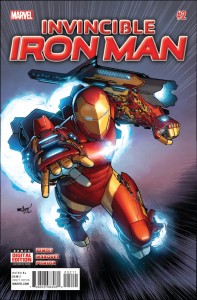 tech skills and ruthless business smarts to create a big-time corporation, and Peter ran with the idea when he came back; now, as CEO of Parker Industries, he’s more Tony Stark or Bruce Wayne than the nebbishy high-school student and part-time photographer of the early years. This is probably all doomed to come crashing down at some point, but for now it’s a refreshing, and logical, use of his many abilities, and opens up a lot of storylines that Slott’s making the most of. Invincible Iron Man has Brian Michael Bendis, fresh from his X-Men and Avengers runs, in Tony Stark’s driving seat, and so far the big guest-stars are Madame Masque and a non-armored, only-a-tiny-scarred Doctor Doom, who swears he’s no longer a bad guy and needs Tony’s help. This, of course, will last even less
tech skills and ruthless business smarts to create a big-time corporation, and Peter ran with the idea when he came back; now, as CEO of Parker Industries, he’s more Tony Stark or Bruce Wayne than the nebbishy high-school student and part-time photographer of the early years. This is probably all doomed to come crashing down at some point, but for now it’s a refreshing, and logical, use of his many abilities, and opens up a lot of storylines that Slott’s making the most of. Invincible Iron Man has Brian Michael Bendis, fresh from his X-Men and Avengers runs, in Tony Stark’s driving seat, and so far the big guest-stars are Madame Masque and a non-armored, only-a-tiny-scarred Doctor Doom, who swears he’s no longer a bad guy and needs Tony’s help. This, of course, will last even less  long than Parker Industries, but it’s a good idea for a leadoff story, and as always with Bendis the dialogue is the high point (both between Tony/Doom and Tony/Masque); Marquez, who worked with Bendis on a bunch of Ultimate Spider-Man issues, is very good at both the straight superhero stuff and the human expressions needed to sustain all that talking, so together they make this an effective relaunch. S.H.I.E.L.D. is worth noting because Mark Waid’s been delivering solid, clever one-issue stories with a mix of the TV team and the Marvel Universe; here, he’s using the obscure, and aging, spy/mercenary Dominick Fortune, but the big news is that the art’s by Fortune’s creator, Howard Chaykin, and that’s always worth celebrating.
long than Parker Industries, but it’s a good idea for a leadoff story, and as always with Bendis the dialogue is the high point (both between Tony/Doom and Tony/Masque); Marquez, who worked with Bendis on a bunch of Ultimate Spider-Man issues, is very good at both the straight superhero stuff and the human expressions needed to sustain all that talking, so together they make this an effective relaunch. S.H.I.E.L.D. is worth noting because Mark Waid’s been delivering solid, clever one-issue stories with a mix of the TV team and the Marvel Universe; here, he’s using the obscure, and aging, spy/mercenary Dominick Fortune, but the big news is that the art’s by Fortune’s creator, Howard Chaykin, and that’s always worth celebrating.
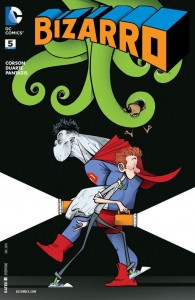 Bizarro #5 (of 6) — Writer: Heath Carson; Art: Gustavo Duarte; Colors: Pete Pantazis
Bizarro #5 (of 6) — Writer: Heath Carson; Art: Gustavo Duarte; Colors: Pete Pantazis
Black Canary #5 — Writer: Brenden Fletcher; Art: Pia Guerra with Sandy Jarrell; Colors: Lee Loughridge
Martian Manhunter #5 — Writer: Rob Williams; Layouts: Eddy Barrows; Pencils: Diogenes Neves; Inks: Mark Deering; Colors: Gabe Eltaeb
Justice League #45 — Writer: Geoff Johns; Art: Francis Manapul; Colors: Manipul with Brian Buccellato
 A bunch of DC books — Bizarro is the most surprising; it’s grown on me with every issue, especially Duarte’s droll cartoony style, while Carson’s script has more layers than you might expect, with themes of friendship and betrayal scattered among the zaniness. Being a six-issue mini-series means it gets a set ending, too, which makes the story stronger; I don’t think sales have been stellar on this book, but I’d buy a sequel in a minute. Black Canary, after a strong start, has been wandering around a little, as Dinah and her new rock group are caught between super-spy subplots and a Jem and the Holograms-ish battle of the bands, but as it’s winding up its own first arc the plot’s making more sense — and
A bunch of DC books — Bizarro is the most surprising; it’s grown on me with every issue, especially Duarte’s droll cartoony style, while Carson’s script has more layers than you might expect, with themes of friendship and betrayal scattered among the zaniness. Being a six-issue mini-series means it gets a set ending, too, which makes the story stronger; I don’t think sales have been stellar on this book, but I’d buy a sequel in a minute. Black Canary, after a strong start, has been wandering around a little, as Dinah and her new rock group are caught between super-spy subplots and a Jem and the Holograms-ish battle of the bands, but as it’s winding up its own first arc the plot’s making more sense — and 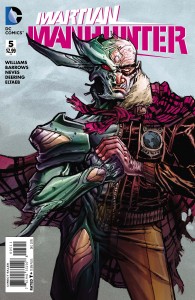 Guerra’s art is very clear and reader-friendly. I’m not that big a fan of DC’s every-month alternate covers, but this issue sports one by Michael Allred of Dinah as a zombie (it’s October, so “monster month” is the theme), and it’s too good to pass up; only Allred could make a pile of corpses simultaneously pop art-y, creepy and fun. Martian Manhunter is another book that’s been better than expected; Williams is one of those guys who’s been writing under the radar for a while (his most high-profile book was probably the Thanos: A God Up There Listening mini-series) and this has been a break-out book for him, with its fun mix of horror, adventure and humor elements as J’onn, fighting a Martian invasion, has “died,” scattering his consciousness among a bunch of unknowing avatars who now have to get
Guerra’s art is very clear and reader-friendly. I’m not that big a fan of DC’s every-month alternate covers, but this issue sports one by Michael Allred of Dinah as a zombie (it’s October, so “monster month” is the theme), and it’s too good to pass up; only Allred could make a pile of corpses simultaneously pop art-y, creepy and fun. Martian Manhunter is another book that’s been better than expected; Williams is one of those guys who’s been writing under the radar for a while (his most high-profile book was probably the Thanos: A God Up There Listening mini-series) and this has been a break-out book for him, with its fun mix of horror, adventure and humor elements as J’onn, fighting a Martian invasion, has “died,” scattering his consciousness among a bunch of unknowing avatars who now have to get  back together to save the day. Justice League continues the Darkseid War arc, with the big guy now dead, and the various leaguers all transformed by their stay on Apokalips: Batman refuses to leave the Mobius chair and is the New God of Information; Flash has merged with the Black Racer and is the New God of Death, etc. The only problem with all of this is that, absent any crossovers with other books, they’re breaking out a bunch of one-shots in the next few weeks showing how each character handles his newfound abilities (Darkseid War: Batman, Darkseid War: Flash, etc.); Johns isn’t writing any of them, and the creative teams have no standout names, so good luck to readers of them while we wait for Justice League #46.
back together to save the day. Justice League continues the Darkseid War arc, with the big guy now dead, and the various leaguers all transformed by their stay on Apokalips: Batman refuses to leave the Mobius chair and is the New God of Information; Flash has merged with the Black Racer and is the New God of Death, etc. The only problem with all of this is that, absent any crossovers with other books, they’re breaking out a bunch of one-shots in the next few weeks showing how each character handles his newfound abilities (Darkseid War: Batman, Darkseid War: Flash, etc.); Johns isn’t writing any of them, and the creative teams have no standout names, so good luck to readers of them while we wait for Justice League #46.
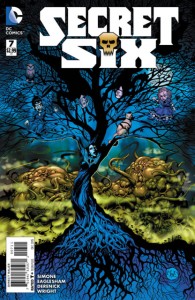 Secret Six #7 — Writer: Gail Simone; Art: Dale Eaglesham and Tom Derenick; Colors: Jason Wright
Secret Six #7 — Writer: Gail Simone; Art: Dale Eaglesham and Tom Derenick; Colors: Jason Wright
Clean Room #1 — Writer: Gail Simone; Art/Colors: Jon Davis-Hunt
Two by Simone, who’s one of comics’ best writers at the moment: her Secret Six has been dark, cynical fun for a couple of years now, and this issue, which sees the magic-soaked goth teen Black Alice becoming an unwilling threat to the world, with her loosely-connected team of former 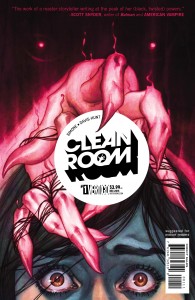 and current bad guys and misfits fighting to save her, is a typical example of its charms (it’s also got a stunning, beautifully eerie cover by the Eaglesham/Wright artist/colorist team that’s worth the $2.99 cover price by itself — as always, click on the thumbnails to see larger versions). Clean Room, published through DC’s more creator-friendly Vertigo imprint, is a horror story about a journalist investigating a self-help guru (her fiancee read one of the woman’s books and ended up killing himself) with apparent occult links; the first issue starts slowly, but keeps accumulating odd little details and mysterious events, and looks like it’ll be as dark and twisted — in a good way — as Simone’s other works.
and current bad guys and misfits fighting to save her, is a typical example of its charms (it’s also got a stunning, beautifully eerie cover by the Eaglesham/Wright artist/colorist team that’s worth the $2.99 cover price by itself — as always, click on the thumbnails to see larger versions). Clean Room, published through DC’s more creator-friendly Vertigo imprint, is a horror story about a journalist investigating a self-help guru (her fiancee read one of the woman’s books and ended up killing himself) with apparent occult links; the first issue starts slowly, but keeps accumulating odd little details and mysterious events, and looks like it’ll be as dark and twisted — in a good way — as Simone’s other works.
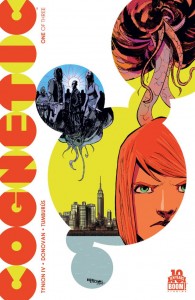 Cognetic #1 (of 3) — Writer: James Tynion IV; Art: Eryk Donovan; Colors: Juan Manuel Tumburus
Cognetic #1 (of 3) — Writer: James Tynion IV; Art: Eryk Donovan; Colors: Juan Manuel Tumburus
Fistful of Blood #1 (of 4) — Creators: Kevin Eastman and Simon Bisley; Colors: Tomi Varga
The Rook #1 — Writer: Steven Grant; Art: Paul Gulacy; Colors: Jesus Aburto
Sunflower #1 (of 6) — Writer: Mark Mallouk; Adaptation: Andi Ewington; Art: Lee Carter; Colors: Lee Carter and Eugenio Perez Jr.
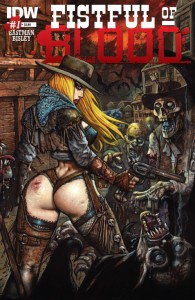 A quartet of indy first issues: Cognetic is about an entity that can jump from consciousness to consciousness, controlling its host body as well as anyone who gets within its psychic range; it gets to New York City and the top of the Empire State Building, and starts attracting attention in the most horrifying way since King Kong. Donovan has a very clear composition style, cinematically staged, although he’s hobbled by a lettering trick that renders all the dialogue in different colors (so we can tell when the entity’s talking, and each other main character, too), and at times can be almost impossible to decipher. It reads like something Mike Carey might come up with, or the Luna brothers (like their Sword), and has a last-page twist that should bring readers back for more. Fistful of Blood is
A quartet of indy first issues: Cognetic is about an entity that can jump from consciousness to consciousness, controlling its host body as well as anyone who gets within its psychic range; it gets to New York City and the top of the Empire State Building, and starts attracting attention in the most horrifying way since King Kong. Donovan has a very clear composition style, cinematically staged, although he’s hobbled by a lettering trick that renders all the dialogue in different colors (so we can tell when the entity’s talking, and each other main character, too), and at times can be almost impossible to decipher. It reads like something Mike Carey might come up with, or the Luna brothers (like their Sword), and has a last-page twist that should bring readers back for more. Fistful of Blood is 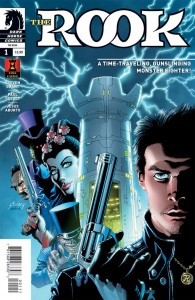 Kevin Eastman taking a Bisley story they did for Heavy Metal back at the turn of the century, and remastering it. It’s a Clint Eastwood spaghetti western, except that instead of the Man With No Name there’s a Woman With No Name Dressed in a Porn Movie’s Idea of a Gunfighter’s Outfit, and the warring sides she walks in on are zombies and vampires, not ranchers or cattlemen. Kind of Bisley-primitive, but at only four issues hard to pass up. The Rook is the old Warren Magazine time-traveller, and opens with a sort-of origin story that’s suitably twisty and solidly-built by Grant, and gives us a chance to see new Paul Gulacy art (between him, Bisley and Howard Chaykin over at Marvel, it’s been a good week for old-school illustrators). Sunflower
Kevin Eastman taking a Bisley story they did for Heavy Metal back at the turn of the century, and remastering it. It’s a Clint Eastwood spaghetti western, except that instead of the Man With No Name there’s a Woman With No Name Dressed in a Porn Movie’s Idea of a Gunfighter’s Outfit, and the warring sides she walks in on are zombies and vampires, not ranchers or cattlemen. Kind of Bisley-primitive, but at only four issues hard to pass up. The Rook is the old Warren Magazine time-traveller, and opens with a sort-of origin story that’s suitably twisty and solidly-built by Grant, and gives us a chance to see new Paul Gulacy art (between him, Bisley and Howard Chaykin over at Marvel, it’s been a good week for old-school illustrators). Sunflower  is from 451 Media, a new comics company bankrolled by Michael Bay; it’s listed as “created and written” by Mark Mallouk, the co-writer of the new Johnny Depp movie Black Mass, but it also credits Andi Ewington as “adapter,” so whether it was originally a Mallouk screenplay, or they talked about it over coffee and then Ewington ghosted it, is anybody’s guess. In any event, you can see why Bay was attracted to it; its story, about a woman whose daughter disappeared and was presumed dead fifteen years ago, who today gets a postcard that seems to be from her and goes to a creepy, hostile small town to investigate, has all the convenient coincidences and gaping plot holes of a Transformers movie.
is from 451 Media, a new comics company bankrolled by Michael Bay; it’s listed as “created and written” by Mark Mallouk, the co-writer of the new Johnny Depp movie Black Mass, but it also credits Andi Ewington as “adapter,” so whether it was originally a Mallouk screenplay, or they talked about it over coffee and then Ewington ghosted it, is anybody’s guess. In any event, you can see why Bay was attracted to it; its story, about a woman whose daughter disappeared and was presumed dead fifteen years ago, who today gets a postcard that seems to be from her and goes to a creepy, hostile small town to investigate, has all the convenient coincidences and gaping plot holes of a Transformers movie.
 Tokyo Ghost #2 — Writer: Rick Remender; Art: Sean Murphy; Colors: Matt Hollingsworth
Tokyo Ghost #2 — Writer: Rick Remender; Art: Sean Murphy; Colors: Matt Hollingsworth
A quick shout-out to this; it can be a little talky, with some origin stuff and world-building, but my God Remender knows how to play to Murphy’s strengths: you think of him as being good with expressions and people talking, but it really opens up toward the end, with a double-page urban-jungle chase splash that’s just breathtaking, and a full-panel last-page that’s almost as good.
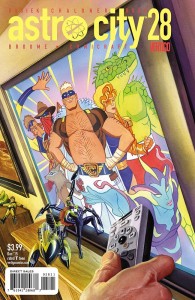 Astro City #28 — Writer: Kurt Busiek; Pencils: Gary Chaloner; Inks: Wade von Grawbadger; Colors: Wendy Broome
Astro City #28 — Writer: Kurt Busiek; Pencils: Gary Chaloner; Inks: Wade von Grawbadger; Colors: Wendy Broome
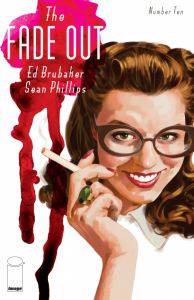 The Fade-Out #10 — Writer: Ed Brubaker; Art: Sean Phillips; Colors: Elizabeth Breitweiser
The Fade-Out #10 — Writer: Ed Brubaker; Art: Sean Phillips; Colors: Elizabeth Breitweiser
Groo: Friends and Foes #10 — Creator/Artist: Sergio Aragones; Wordsmith: Mark Evanier; Colors: Tom 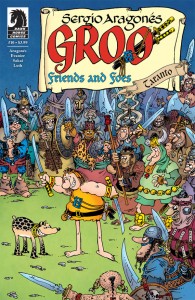 Luth
Luth
Lumberjanes #19 — Writers: Shannon Watters and Kat Leyh; Art: Carolyn Nowak; 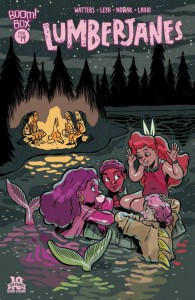 Colors: Maarta Laiho
Colors: Maarta Laiho
Usagi Yojimbo #149 — Creator: Stan Sakai
These are all books-I’ve-talked-about-a-lot, so, really, just shut up and buy them too. Astro City offers a typically-clever and well-conceived one-issue tale about an  Ant-Man/Doll Man-type character; The Fade-Out is crime noir set in late-’40s Hollywood (with Phillips’s sexy pulp-portrait cover a perfect summary of the book’s strengths); Groo, Lumberjanes and Usagi Yojimbo are all great all-ages comics, with Groo offering the legendary Sergio Aragones and his slapstick barbarian, Lumberjanes its plucky scouting-summer-camp girls and their adventures in a fantasy-tinged forest, and Usagi Yojimbo Stan Sakai’s ronin rabbit, in a done-in-one-issue gem so well-made that it could have been an episode of Lone Wolf and Cub.
Ant-Man/Doll Man-type character; The Fade-Out is crime noir set in late-’40s Hollywood (with Phillips’s sexy pulp-portrait cover a perfect summary of the book’s strengths); Groo, Lumberjanes and Usagi Yojimbo are all great all-ages comics, with Groo offering the legendary Sergio Aragones and his slapstick barbarian, Lumberjanes its plucky scouting-summer-camp girls and their adventures in a fantasy-tinged forest, and Usagi Yojimbo Stan Sakai’s ronin rabbit, in a done-in-one-issue gem so well-made that it could have been an episode of Lone Wolf and Cub.



